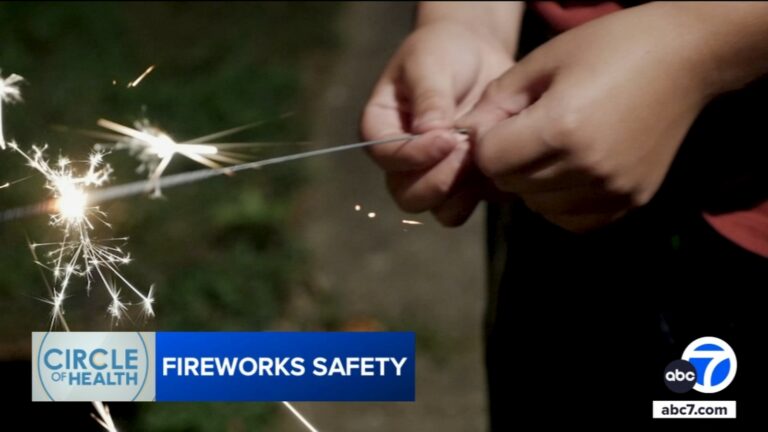LOS ANGELES (KABC) — Fourth of July fireworks are an American tradition, but they’re not entirely harmless. The Consumer Product Safety Commission (CPSC) reports that emergency room visits for fireworks injuries are increasing year over year. But even a professional fireworks display can have long-term health effects in ways that might surprise you.
If you’re planning on hosting your own backyard fireworks show, keep in mind that nearly 10,000 people were treated for fireworks-related injuries last year alone.
Doctors recommend wearing pants, closed shoes and protecting your eyes.
Explosive and projectile fireworks are illegal in California, but even those labeled “safe and wholesome” like fountains, sparklers and pinwheels should be handled with care. Sparklers can burn up to 2,000 degrees, a temperature high enough to melt metal.
Light one firework at a time and designate one person to set them off.
“First figure out who’s lighting the fireworks. You know, one of the things we recommend is that children not be involved,” said Dr. Allan Capin, an urgent care specialist at the Cleveland Clinic.
Stay on a flat concrete surface or sidewalk. Grass can burn easily. If a firework does not ignite, never try to relight it as it may be delayed. Soak it in water.
And if you do experience a mild burn, Capin advises avoiding using ice to relieve the pain.
“It’s not a good idea to add ice. Ice is the enemy because as soon as you apply ice, you decrease blood flow to the area, which can actually cause more pain and make the burn worse,” he said.
Rather than risk injury, firefighters encourage people to attend organized, professional demonstrations. But people often overlook the dangers of high-decibel noise. Neurotologist Courtney Voelker of the Pacific Neuroscience Institute says just one loud blast can cause hearing loss and ringing in the ears. She suggests downloading a decibel-reading app and bringing hearing protection.
“Get some of those foam earplugs that are over the counter. And when the noise level goes above 85 decibels, hand out those earplugs,” Voelker said.
A study from the University of California, Irvine, found that fireworks can cause an increase in fine particles, similar to wildfire smoke. These particles are linked to respiratory and heart disease, but more research is needed to determine the role of proximity and duration of exposure in the risk.
Aside from air pollution, the number of COVID cases in Los Angeles County is the highest it’s been all year, averaging more than 200 cases per week. So in addition to bringing earplugs to a fireworks show, researchers say you should also bring an N-95 mask if you’re likely to suffer from respiratory issues.
Copyright © 2024 KABC Television, LLC. All rights reserved.


